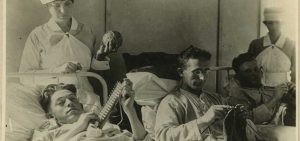Written By: Melinda Butler, OTR/L, OTD, BCPA
Occupational Therapy is a unique medical profession because its origins are not based on a traditional medical model. Let’s rewind 100+ years to 1917:
- Reconstructive aids were utilized during World War I, to help wounded soldiers “reconstruct their lives” through the use arts and crafts.
- Background of early occupational therapists: was teachers, secretaries, and artists.
- Goal of early reconstructive aide services: take soldiers’ minds of their injuries, increase physical activity, and improve their overall outlook.
- Societal movement for the moral treatment of persons with psychiatric conditions.
Eventually, occupational therapy became recognized as a science driven, evidence-based profession. In light of Occupational Therapy Month, I found it befitting to discuss ways that occupational therapy practitioners (OTPs) can best demonstrate the distinct value of Occupational Therapy in the everchanging world of Medicare.
1960s – Medicare is born and OT focuses on Community-Based Care
Prior to 1960s, occupational therapy services were limited to hospital settings. However, with the Geriatric Consumerism Movement and the Community Mental Health Act of 1963, occupational therapy began to focus on mental health and community-based care. Then in 1965, the following pivotal changes occurred:
- The Social Security Administration Act was signed into law by President Lyndon B. Johnson.
- Medicare and Medicaid were established.
- AOTA started the American Occupational Therapy Foundation (AOTF), a non-profit organization centered on policy and advocacy with a primary goal of advancing the science of OT.
- The term “Occupational Science” was adapted by the profession and quickly became the focus of research and treatment methodology.
OT is introduced to the SNF
From the 1970s to 1990s, occupational therapy began to embrace its holistic roots once again with a community focus. This brought about more specialized practice areas and settings including:
- prevention and wellness
- ergonomic and work programs
- assistive technology
- geriatrics (and increasing chronic medical conditions)
Additionally, in 1986 occupational therapy became a provider of Medicare part B services. This change in the industry introduced occupational therapy to the SNF setting and quickly brought about new opportunities for the profession; but not without its challenges. A profession rooted largely in art, social work, and education must now prove through documentation that it is services are “medically necessary” for Medicare reimbursement. This, coupled with productivity demands make it challenging to address ADL and IADL needs in a way that is practical and holistic.
Keeping it Relevant
To address these challenges, many OTPs feel pressure to fit OT into a PT mold. Upper extremity strengthening has quickly become a go-to treatment but there are times that this doesn’t fit a logical framework for treatment. For example, a Medicare reviewer would not expect that a hip replacement would result in upper extremity weakness. However, a person may still have ADL deficits due to the joint pain and instability post-surgery. This presents a quandary for OTPs who are pressured to provide upper body therapeutic exercise. Well good news! With an evidence-based methodology and the use of occupation-based standardized assessments, occupational therapy professionals can both meet the demands of Medicare to establish medical necessity, while also maintaining the integrity and organic roots of the occupational therapy profession.
Want to know more? Be sure to register for this course coming soon! It is proven to be beneficial for all therapy disciplines – Medicare Documentation: Practical Strategies for Justifying Therapy Services. Together, we can advocate for the efficacy of Occupational Therapy and support its rich legacy.
References:
- Allen, C. Foto, M. Moon-Sperling, T. Wilson, D. (updated 2020). A Medical Review Approach to Medicare Outpatient Documentation. American Journal of Occupational Therapy, 1989;43(12):793-800. Retrieved from: https://doi.org/10.5014/ajot.43.12.793
- American Occupational Therapy Association. Celebrating AOTA’s Centennial Vision: A Brief History of Occupational Therapy [Video]. Retrieved from: www.myotspot.com March 21, 2020.
- American Physical Therapy Association. (2020). Medicare Postacute Care Reform. http://www.apta.org/your-practicepayment/medicare-payment/coding-billing/medicare-post-acute-care-reform Centers for Medicare and Medicaid. (Rev. 10-4-19). Medicare Benefit Policy Manual chapter 8 (SNF). Retrieved from: https://www.cms.gov/Regulations-and-Guidance/Guidance/Manuals/Downloads/bp102c08pdf.pdf
Other Courses by Melinda Butler, OTR/L, OTD, BCPA:
Functional Geriatrics: Documentation and Treatment Strategies
Creating Value-Based Treatment
Ethical Trends in Occupational Therapy
Preventing and Preparing for Medicare Audits
Successful Implementation of the PDPM & PGPM
Coding and Billing for the PDPM and PGPM
Coming Soon:
Rehabilitation for the Frail or Cognitively-Impaired Older Adult: Part I
Rehabilitation for the Frail or Cognitively-Impaired Older Adult: Part II




